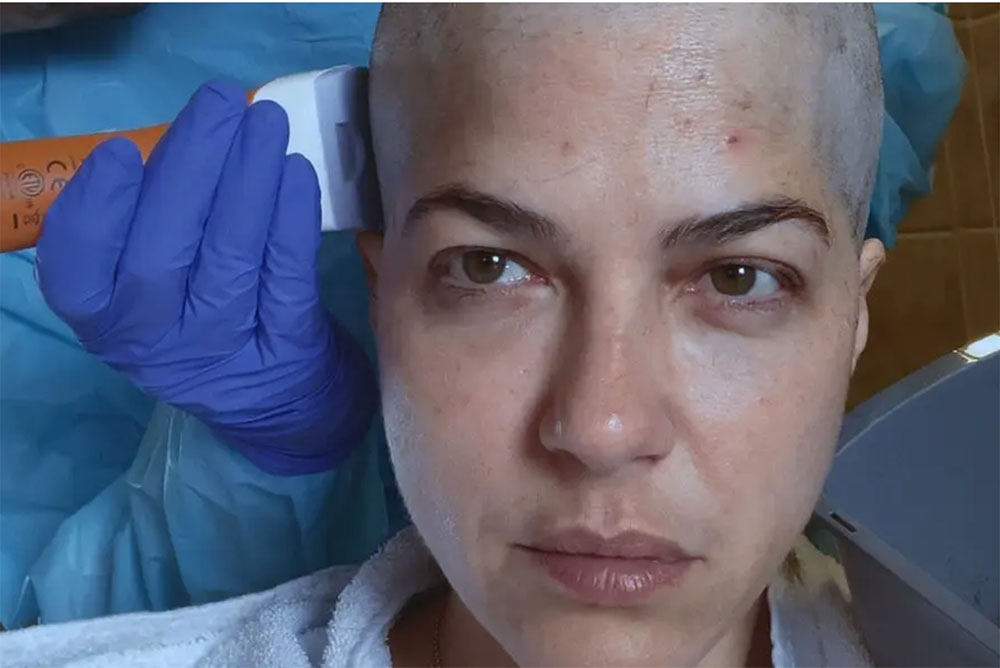
Selma Blair in “Introducing, Selma Blair” / Strand Releasing/Discovery+
By Mary Carpenter
“INTRODUCING, Selma Blair” (streaming on Discovery Plus) shines a light on the challenges of living with an autoimmune disease —in this case multiple sclerosis (MS). For the actress whose MS was diagnosed in 2018, stumbling and slurred speech mark the flares—interspersed with remissions of well-being, including one that could last decades following a recent stem cell transplant.
Autoimmune diseases—in which antibodies produced by the body to counter infections and other foreign invaders turn against the body’s own cells and tissues—are on a dramatic upswing in the U.S. Prevalence has risen from about 11% of the population in 1995 to almost 16% in 2020—from about 22 million to 41 million individuals affected. The ever-changing, most prevalent autoimmune disease list of more than 80 conditions includes type 1 diabetes, rheumatoid arthritis (RA), psoriasis/psoriatic arthritis, MS, lupus and inflammatory bowel disease (IBS, encompassing Crohn’s disease and ulcerative colitis.)
Women make up about 80% of autoimmune disease sufferers around the world: 80 to 95% of those with lupus and Sjogren’s syndrome; and about 60% with MS and most forms of arthritis (except osteoarthritis), writes medical geneticist Karen Orstavit at the University of Oslo. Estrogen levels affect the risk—with many autoimmune diseases in women starting shortly after puberty and often changing during pregnancy.
“Long Covid” shares many of the same “terrible debilitating symptoms” —heart palpitations, crippling fatigue, extreme brain fog, shortness of breath—reported by those with autoimmune diseases, according to a podcast conversation between Ross Douthat and Meghan O’Rourke, writers for The New York Times, The Atlantic and elsewhere. Long Covid symptoms have occurred in up to 30% of those infected by the virus—more often in younger patients, and in some who had mild cases of the disease.
In addition, the SARS-CoV-2 virus “triggers almost unheard of amounts of autoimmune responses in the body,” said O’Rourke—specifically, very high levels of antinuclear autoantibodies (ANA), which are considered the best physiological marker for autoimmune diseases.
ANA are the antibodies that mistakenly attack healthy cells and tissues. Higher levels often signal active autoimmune disease, but low ANA levels can be present with infections or other medical issues—and can also show up in blood samples long before symptoms of autoimmunity occur.
In ANA studies on patients beginning at Covid diagnosis, those who go on to develop long-haul Covid, as well as those who will be hospitalized with severe disease, had higher ANA numbers early on —providing hope that early ANA levels might help predict patient outcomes.
Many long Covid symptoms are similar to those of Chronic Fatigue Syndrome (CFS) – and many long Covid patients receive a diagnosis of ME/CF (myalgic encephalomyelitis/chronic fatigue). While CFS sufferers may have biomarkers of inflammation and a sustained immune response, CFS has lacked other indicators of autoimmunity, notably identification of the specific organ or organs involved.
Better understanding of both individual susceptibility and the role of environmental risks are increasing along with the prevalence of autoimmune diseases. Environmental triggers of autoimmunity include antigens—viruses and bacteria—but also pollutants and even specific foods that activate the immune system. Gluten is the trigger for Celiac disease; the Epstein-Barr virus for both MS and CFS; and cigarette smoke for rheumatoid arthritis.
“Environmental triggers” can act by turning on inherited genes that make some individuals more susceptible to developing autoimmunity—with several diseases such as RA more prevalent in people with various forms of the HLA-B gene. One form, HLA-B27, is present in more than 80% of patients with ankylosing spondylitis (a kind of arthritis) and to a lesser degree in those with IBS, reactive arthritis and one form of uveitis.
“America’s hidden chronic illness epidemic” is how the podcast conversation described high numbers of patients today reporting autoimmune-like symptoms, such as those of CFS—which generally arise slowly and often have no clear cause. But with Covid, Douthat said, “suddenly tens of thousands of people who weren’t sick before are sick with something new in the span of three to six months.”
The result: “the medical system as a whole [is] much more responsive to long Covid than it has been to other chronic illnesses,” said Douthat. But, maybe more important, “so many doctors either got sick with Covid or know someone who got sick with Covid.” As one doctor told Douthat, “these are my colleagues…And they were able to report on and be detectives about their symptoms in a way that might have been harder for a person who didn’t have medical training.”
Patients with autoimmune-like symptoms—including those without a formal diagnosis, notably for CFS-like symptoms—who have difficulty getting medical attention can find help in functional or integrative medicine, writes Austin-based functional medicine specialist Amy Myers on Huffington Post. Strategies include optimizing the diet to reduce inflammation and help repair the gut— by eating organic foods, filtering air and water and reducing use of plastic; healing infections like herpes; and relieving stress.
Even with an autoimmune diagnosis like MS, some patients do not respond well to mainstay treatments. For them, recent innovations in biologic medications made from living cells have offered new hope. Results with biologics can be as good or better than those from stem cell transplants such as Selma Blair’s, but without the side effects or risks: a new clinical trial aims to compare the two.
On the other hand, one patient who had a stem cell transplant in 2002 has not taken any “disease-modifying drugs” in the almost 20 years since. While the chemotherapy needed for the transplantation has side effects such as early menopause, gradual milestone achievements for this patient went from grocery shopping without fatigue to returning to work; and from using a wheelchair and walker to swimming, kayaking and downhill skiing.
—Mary Carpenter
—Mary Carpenter regularly reports on topical subjects in health and medicine.
